The Soundscape Indices (SSID) Protocol: A Method for Urban Soundscape Surveys—Questionnaires with Acoustical and Contextual Information
Abstract
1. Introduction
Purpose
2. Protocol Design and Equipment
2.1. Labeling and Data Organization
2.2. Location and Measurement Point Selection
2.3. Equipment
3. Techniques for Field Data Collection
3.1. Questionnaire Surveys
- The core questionnaire is reported in Appendix C. The labels and corresponding scales are also reported. Ideally, the form should be submitted and filled on a tablet via a survey app (e.g., REDCap, Qualtrics, KoBoToolbox, or similar) so that data can then be easily downloaded in an .xlsx or .csv file. Using paper forms is also acceptable; however, researchers on site will need to take more careful note of information such as the time of response and the information will need to be manually input after the session is completed. If using an electronic version, the system should be set up to record the start and end times and GPS coordinates for each survey.
- If using an electronic version, be sure to have enough tablets with internet connectivity (if required by the survey system) and sufficient battery life; if using the paper version, be sure to print enough copies. Even if using the electronic version, it is recommended to also print a number of paper versions as a backup or if a large group agrees to participate at once.
- Regardless of the translation of the items, it is important that the label (e.g., SSI01) is kept, as well as the size and direction of the scales (1–5, etc.) to maintain data consistency.
3.2. Contextual and Environmental Factor Data Collection
3.2.1. Spatial Audio-Visual Recordings
- The audio-video recordings can be done before or after the questionnaire survey.
- The purpose of the audio-video recordings is to capture representative recordings which can be reproduced in a laboratory setting. During the first time at a location, the focus should be on capturing the environment as experienced by the respondents to the questionnaires at that location. Therefore, the recordings should be performed in nearly the same spot, with similar lighting and environmental conditions. For further survey sessions, provided the conditions are similar, other recordings could be taken which provide additional perspectives around the space for reproducing in the lab.
- These recordings can be performed entirely separately from the questionnaire survey, if desired. Reasons for doing this may be (but are not limited to): location is not populated, making questionnaires impossible; specific locations or conditions are required for a lab experiment; time limitations require many sites in an area to be captured and in situ questionnaires could not be completed in time.
- The 360° video will take a significant amount of storage space. Researchers should ensure that there is ample free space on the camera SD cards prior to going out on site. If conducting multiple surveys away from their home institution (i.e., in another city), teams are recommended to bring a large external hard drive so that videos can be offloaded after each session.
3.2.2. Reference Recordings
4. Procedure
4.1. Assembling the Equipment
- Set up the equipment by prioritizing the position of the 360° camera and position the lens at the average eye level 160–180 cm, as shown in Figure 2.It is advisable to test the setup for video stitching issues and reconfigure if needed (e.g., the equipment will be partially visible in the raw video recording, so you need to test if the chosen setup allows for efficient erasing/hiding/patching of the exposed parts in the post-processing). Companies selling 360° cameras usually offer free software for basic editing and previewing. It is advisable to position the camera as the highest item in the set to avoid the need for editing both the sky and the ground.
- Carefully position the AMB microphone so its axes are aligned with the axes of the 360° camera; the microphone’s front (usually marked by the logo) and the camera’s front should be looking in the same direction. Many AMB microphones allow them to be oriented vertically or horizontally (end-fire), this should be noted and adjusted in the relevant software settings.This is essential for informed post-processing. It is advisable to position the capsules of the AMB microphone and the capsule of the SLM as near to each other as possible, without introducing scattering effects. It can usually be done within the same windshield unit, but it is not essential to do so and depends on the available clamps and stands.
- The gain settings for the four ambisonic audio channels should be set to the same level. In some devices (such as the MixPre 10), this can be set by locking the channel gain settings to a single channel. Many devices also offer ambisonic plugins which simplify these settings and automatically link the gain settings—these should be used where available.
- Set the SLM to log sound levels and simultaneously record .wav audio. The recommended logging settings are given in Table 3. The SLM should be mounted and positioned according to standard guidance for environmental noise measurements, like that given in Section 9 of ISO 1996-2:2017 [19] or Section 5 of ANSI/ASA S12.9-2013/Part 1 [50]. Generally, the microphone should be a minimum of 1.2 m above the ground and a minimum of 1 m from any vertical reflecting surfaces.
- Attach the environmental meter(s) to the tripod. Care should be taken when positioning the environmental monitor. Most units will include guidance on their use from the manufacturer—these should be followed where available. Some general items to keep in mind include not accidentally covering air quality sensor holes, not positioning light sensors in the shade of the other equipment, and not positioning temperature sensors in direct sunlight unless this is how they are intended to be positioned.
4.2. Recording Stage
- Double check all settings and file save locations on the recording equipment.
- Adjust gain settings to ensure there is no clipping. Good practice is to listen for what is expected to be the loudest sound event during the recording period (e.g., sirens) and set the gain such that the level is comfortably under clipping during this event.
- Start recording on all devices, including the ambisonic microphone, 360° camera, SLM, and environmental meter.
- Stand at the front of the camera/ambisonic microphone and clap. The clap can help synchronize the audio with the video, if necessary, and ensuring you are standing in line with the front of the 360° video can help with lining up the directionality of the two, if necessary.
- Retreat out of view of the camera, blending into the surrounding crowd, or otherwise make sure not to be obvious to someone watching the video.
- Record at least 5 min of consistent and representative audio and video. It is recommended to record for 15 min to give the best chance of being able to extract a solid 5 min of useful video and audio.
- Stop recording on all devices and ensure all files are saved properly.
4.3. Questionnaire Stage
- Double check all settings and file save locations on the recording equipment. If starting this stage immediately after the Recording Stage, make sure to rename or advance the index on the filenames for the SLM and environmental meters.
- Start recording on the SLM and environmental meter (or leave running from preceding Recording Stage). These will continue running until the end of the Questionnaire Stage.
- Gather the tablets and/or paper questionnaires and prepare to approach potential participants.
- Approach participants and ask if they would be willing to take part in a research study. If the participants are in a group, they can participate at the same time, but should each fill out a separate questionnaire. When approaching participants, you should identify yourself as a researcher or student researching urban sound. We advise avoiding phrases such as “noise”, “noise pollution”, “noise disturbance” or other terms which carry a negative connotation. In general, explanations and answers to questions should strive to be as neutral as possible regarding the nature of the soundscape.
- Once the participant has consented to participate, hand them the questionnaire or tablet and provide them with basic instructions for answering the questionnaire. Emphasize that they should be responding and assessing the current sound environment, in the current place. Note that this is a common misunderstanding—many participants assume the questionnaire is focused on the sound environment at their home, or in the city in general. Where a mix of tablets and paper questionnaires are being used, each group should have at least one participant using a tablet such that start and end times and precise GPS coordinates can be pulled from the accompanying electronic questionnaire. While one researcher is interacting with the participants, the second should arrange the equipment for taking the binaural recordings and 360° photo.
- Once the participant has started answering the questionnaire, start recording the binaural audio. If the participants are in a group and all are taking the survey at the same time, only one binaural recording is needed for the whole group. The researcher conducting the recording should strive to keep their head as stationary as possible and to avoid making any extraneous noise.Make sure that at least 30 s of consistent audio is recorded while the participant is filling in the questionnaire. This should not include talking either from the researcher or the participant. If talking or other intrusive (non-representative) sound occurs, extend the recording period to end up with a solid 30 s of good audio. The goal is to capture the sound environment which the participant was exposed to while filling out their questionnaire, but to exclude sounds which the participant is not likely considering as part of their assessment. Most commonly, this would be the researcher talking, or the participant themselves talking. Any other sounds which the participant was “naturally” exposed to should be included.When taking the binaural recording, attempt to orient the head (artificial or researcher wearing a headset) in the same direction as the participants. This is not crucial as it is often impossible to achieve, but it is preferable. Be careful not to move the head during the recording.
- Note the GroupID in the metadata for the binaural recording, or make a manual note of the binaural recording file name and the GroupID separately.
- Take one 360° photo with the camera to capture the general setting. This can also be done at regular intervals during the survey session.
- When the participant has finished filling in the questionnaire, thank them for their participation and fill in the additional researcher questions at the end of the questionnaire. These help to both track the data collected and to document the conditions on site. The most important of these are:
- (For paper versions) Start and End time. If a Start time was not noted, at minimum, the End Time must be recorded and an average survey duration can be subtracted to estimate the Start Time
- GroupID
- SessionID
- Repeat steps 4–9 for the remainder of the session, incrementing the GroupID by one with each new group of participants. If there are more than two researchers on site, the additional researchers can stop new groups of participants simultaneously. The researcher operating the binaural equipment can then shift between the groups once they have finished the 30 s recording. This researcher should also have the responsibility of keeping track of the GroupID numbers for each group. Experience has shown this is possible up to about three groups at a time, with four researchers on site.
- Once the session is finished, stop the equipment and ensure all files are saved properly.
- After each session, make note of the character of the site and the environmental conditions during the survey. This might include, but is not limited to:
- Site typology and intended use (e.g., urban park, transit station, urban square, etc.)
- Weather
- Crowdedness (i.e., how many people are present in the space)
- Dominant sound sources and any key soundmarks
- Visual character (e.g., amount of greenness, enclosed vs. open, etc.)
5. Lessons from International Data Collection
5.1. Sampling
5.2. Data Collection
5.3. Equipment
5.4. Translation
Supplementary Materials
Author Contributions
Funding
Acknowledgments
Conflicts of Interest
Abbreviations
| SSID | Soundscape Indices |
| FOA | First Order Ambisonics |
| PAQ | Perceived Affective Quality |
| ERC | European Research Council |
| VR | Virtual Reality |
| QUE | Questionnaires |
| VID | 360° Video |
| PIC | Site Pictures |
| BIN | Binaural Recording |
| AMB | Ambisonic Video |
| SLM | Sound Level Meter |
| ENV | Environmental Data |
Appendix A. Sample Information Sheet

Appendix B. Sample Consent Form
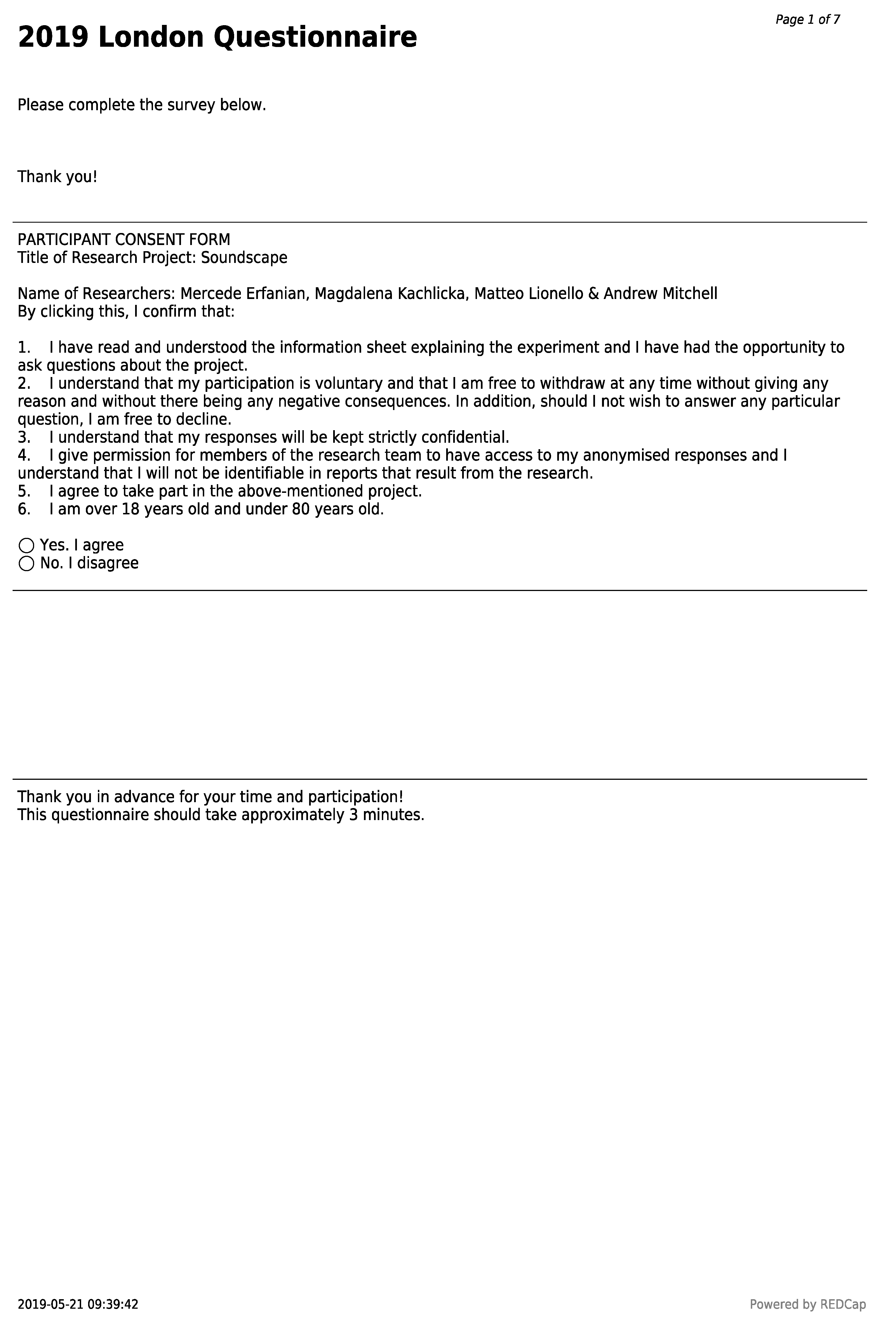
Appendix C. SSID Questionnaire
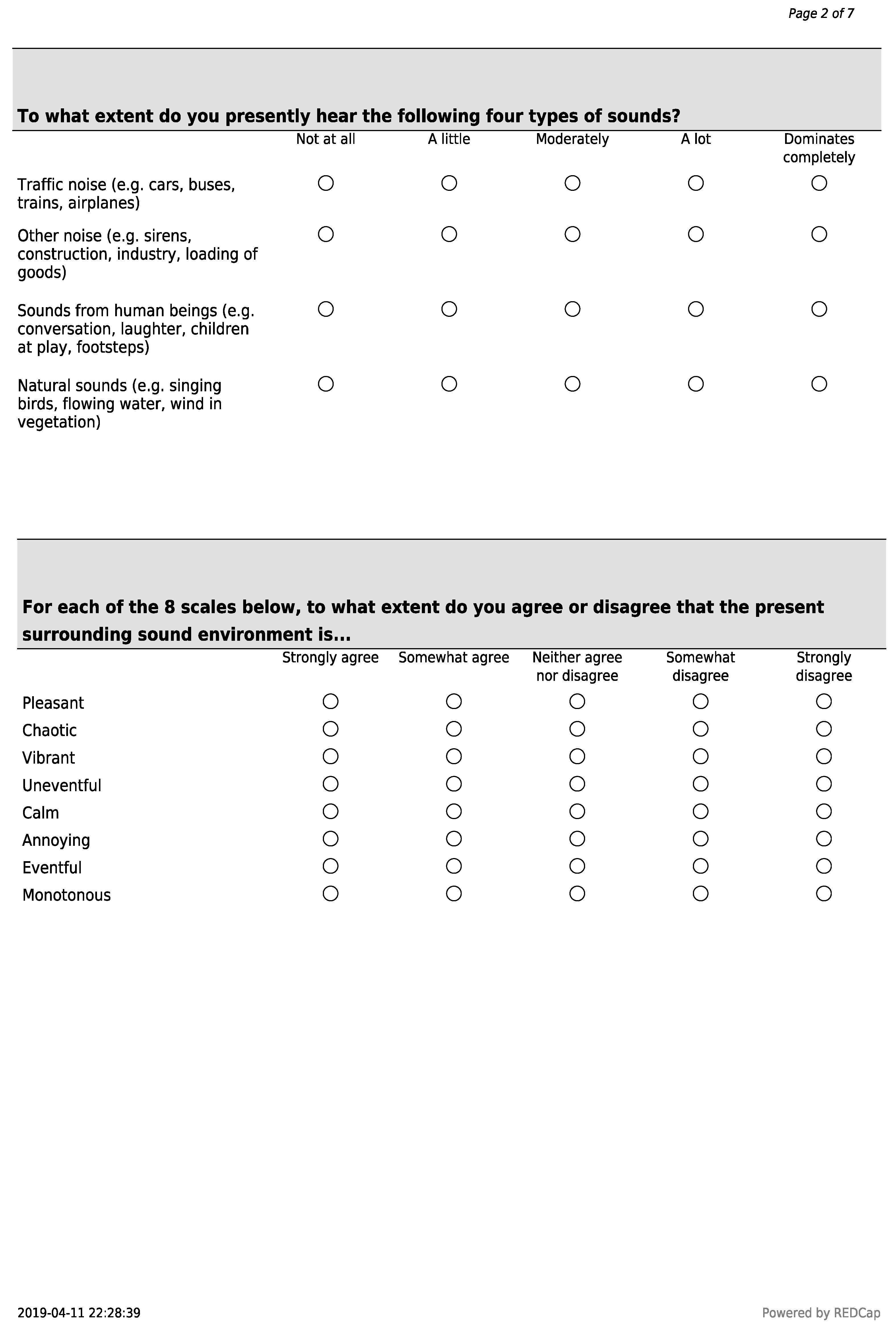
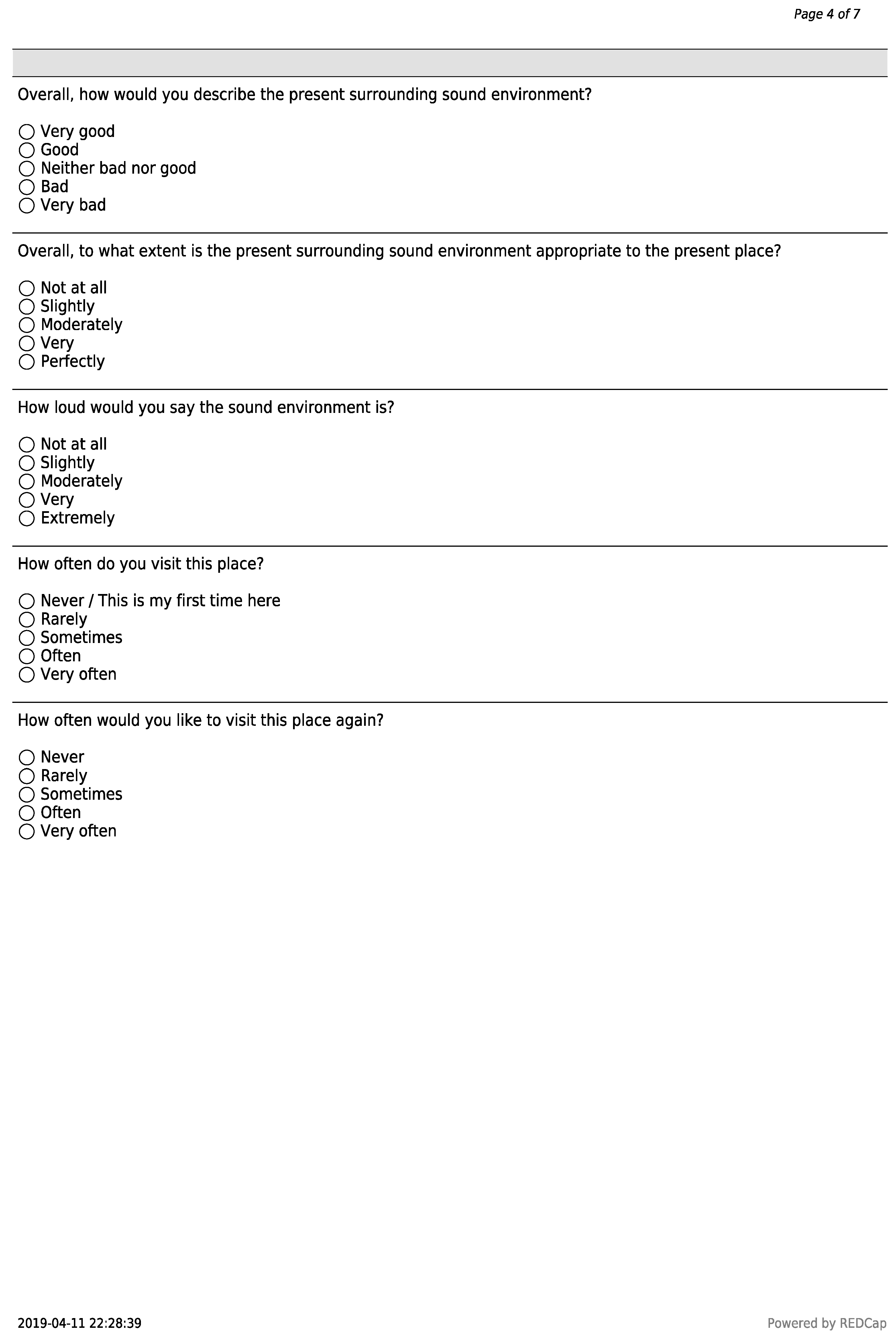

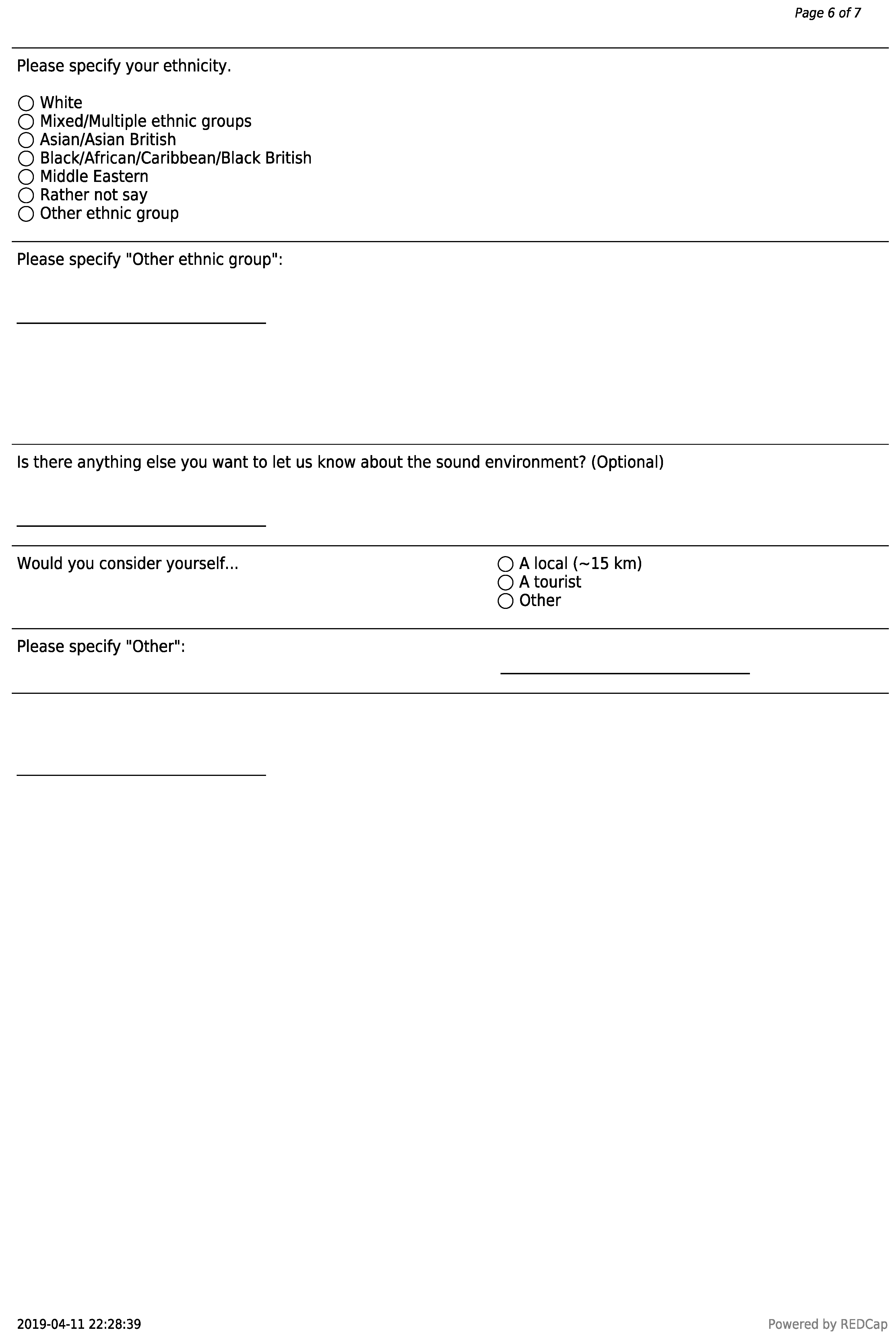
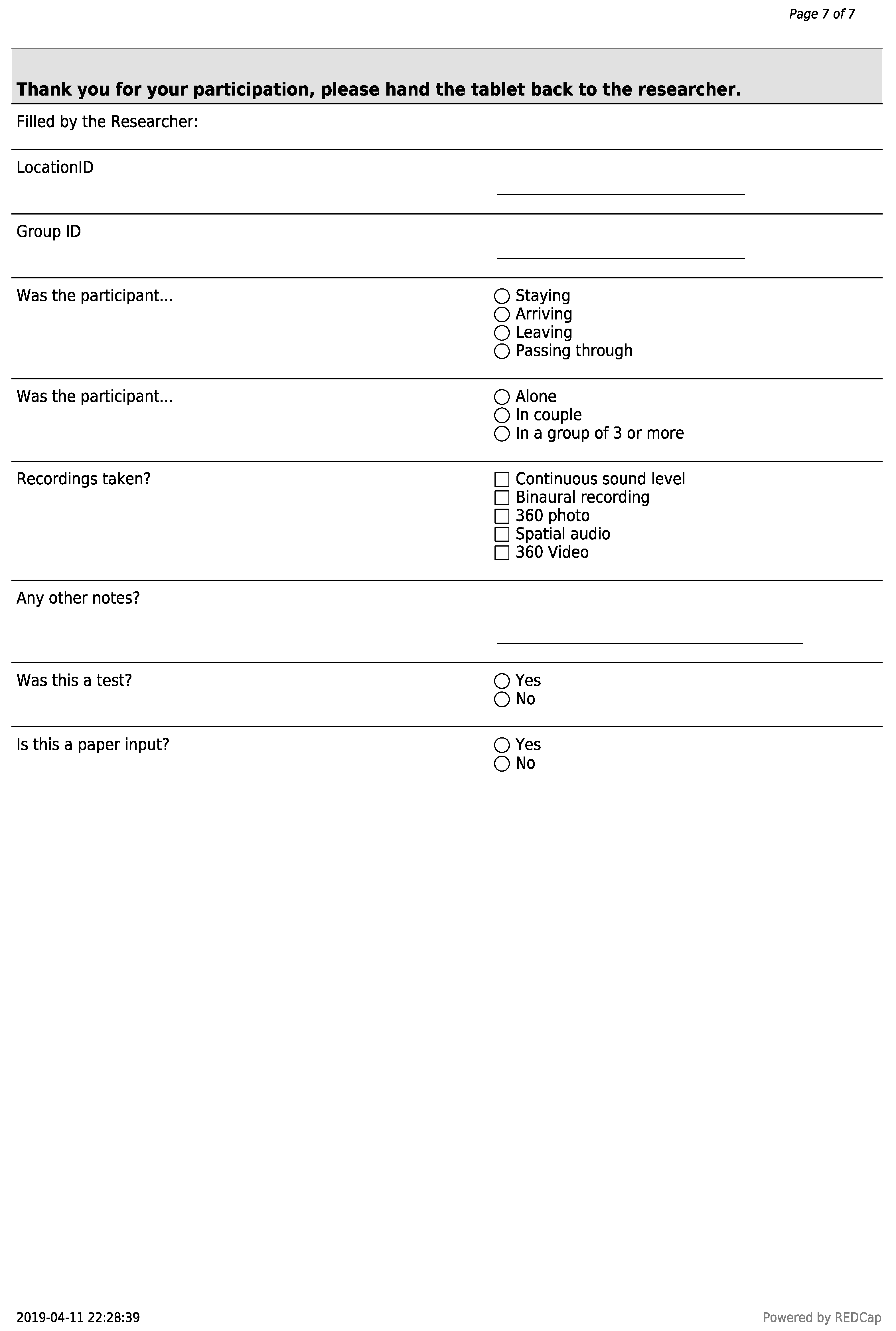
Appendix D. Questionnaire Codebook


References
- Berglund, B.; Nilsson, M.E. On a tool for measuring soundscape quality in urban residential areas. Acta Acust. United Acust. 2006, 92, 938–944. [Google Scholar]
- Aletta, F.; Kang, J.; Axelsson, Ö. Soundscape descriptors and a conceptual framework for developing predictive soundscape models. Landsc. Urban Plan. 2016, 149, 65–74. [Google Scholar] [CrossRef]
- Kang, J.; Aletta, F.; Oberman, T.; Erfanian, M.; Kachlicka, M.; Lionello, M.; Mitchell, A. Towards soundscape indices. In Proceedings of the 23rd International Congress on Acoustics, Aachen, Germany, 9–13 September 2019; pp. 2488–2495. [Google Scholar]
- International Organization for Standardization. ISO 12913-1:2014 Acoustics—Soundscape Part 1: Definition and Conceptual Framework; Standard ISO 12913-1:2014; International Organization for Standardization: Geneva, Switzerland, 2014. [Google Scholar]
- International Organization for Standardization. ISO/TS 12913-2:2018 Acoustics—Soundscape Part 2: Data collection and Reporting Requirements; Standard ISO/TS 12913-2:2018; International Organization for Standardization: Geneva, Switzerland, 2018. [Google Scholar]
- International Organization for Standardization. ISO/TS 12913-3:2019 Acoustics—Soundscape Part 3: Data Analysis; Standard ISO/TS 12913-3:2019; International Organization for Standardization: Geneva, Switzerland, 2019. [Google Scholar]
- Sun, K.; De Coensel, B.; Filipan, K.; Aletta, F.; Van Renterghem, T.; De Pessemier, T.; Joseph, W.; Botteldooren, D. Classification of soundscapes of urban public open spaces. Landsc. Urban Plan. 2019, 189, 139–155. [Google Scholar] [CrossRef]
- Oberman, T.; Šćitaroci, B.B.O.; Jambrošić, K. Towards a virtual soundwalk. In Handbook of Research on Perception-Driven Approaches to Urban Assessment and Design; IGI Global: Hershey, PA, USA, 2018; pp. 317–343. [Google Scholar]
- Craig, A.; Moore, D.; Knox, D. Experience sampling: Assessing urban soundscapes using in-situ participatory methods. Appl. Acoust. 2017, 117, 227–235. [Google Scholar] [CrossRef]
- Lavia, L.; Witchel, H.J.; Aletta, F.; Steffens, J.; Fiebig, A.; Kang, J.; Howes, C.; Healey, P.G. Non-participant observation methods for soundscape design and urban planning. In Handbook of Research on Perception-Driven Approaches to Urban Assessment and Design; IGI Global: Hershey, PA, USA, 2018; pp. 73–99. [Google Scholar]
- Engel, M.S.; Fiebig, A.; Pfaffenbach, C.; Fels, J. A Review of Socio-acoustic Surveys for Soundscape Studies. Curr. Pollut. Rep. 2018, 4, 220–239. [Google Scholar] [CrossRef]
- Yang, W.; Kang, J. Acoustic comfort evaluation in urban open public spaces. Appl. Acoust. 2005, 66, 211–229. [Google Scholar] [CrossRef]
- Rychtáriková, M.; Vermeir, G. Soundscape categorization on the basis of objective acoustical parameters. Appl. Acoust. 2013, 74, 240–247. [Google Scholar] [CrossRef]
- Aumond, P.; Can, A.; De Coensel, B.; Botteldooren, D.; Ribeiro, C.; Lavandier, C. Modeling soundscape pleasantness using perceptual assessments and acoustic measurements along paths in urban context. Acta Acust. United Acust. 2017, 103, 430–443. [Google Scholar] [CrossRef]
- Alsina-Pagès, R.M.; Freixes, M.; Orga, F.; Foraster, M.; Labairu-Trenchs, A. Perceptual evaluation of the citizen’s acoustic environment from classic noise monitoring. Cities Health 2020, 1–5. [Google Scholar] [CrossRef]
- Ricciardi, P.; Delaitre, P.; Lavandier, C.; Torchia, F.; Aumond, P. Sound quality indicators for urban places in Paris cross-validated by Milan data. J. Acoust. Soc. Am. 2015, 138, 2337–2348. [Google Scholar] [CrossRef]
- Zhang, X.; Ba, M.; Kang, J.; Meng, Q. Effect of soundscape dimensions on acoustic comfort in urban open public spaces. Appl. Acoust. 2018, 133, 73–81. [Google Scholar] [CrossRef]
- International Organization for Standardization. ISO 1996-1:2016 Acoustics—Description, Measurement and Assessment of Environmental Noise—Part 1: Basic Quantities and Assessment Procedures; Standard ISO 1996-1:2016; International Organization for Standardization: Geneva, Switzerland, 2016. [Google Scholar]
- International Organization for Standardization. ISO 1996-2:2017 Acoustics—Description, Measurement and Assessment of Environmental Noise—Part 2: Determination of Sound Pressure Levels; Standard ISO 1996-2:2017; International Organization for Standardization: Geneva, Switzerland, 2017. [Google Scholar]
- Ren, X.; Kang, J.; Zhu, P.; Wang, S. Soundscape expectations of rural tourism: A comparison between Chinese and English potential tourists. J. Acoust. Soc. Am. 2018, 143, 373–377. [Google Scholar] [CrossRef] [PubMed]
- Kang, J.; Aletta, F.; Gjestland, T.T.; Brown, A.L.; Botteldooren, D.; Schulte-Fortkamp, B.; Lercher, P.; van Kamp, I.; Genuit, K.; Fiebig, A.; et al. Ten questions on the soundscapes of the built environment. Build. Environ. 2016, 108, 284–294. [Google Scholar] [CrossRef]
- De Coensel, B.; Sun, K.; Botteldooren, D. Urban Soundscapes of the World: Selection and reproduction of urban acoustic environments with soundscape in mind. In Proceedings of the 46th International Congress and Exposition on Noise Control Engineering (Inter-Noise) 2017, Hong Kong, China, 27–30 August 2017; p. 7. [Google Scholar]
- Aletta, F.; Kang, J. Towards an urban vibrancy model: A soundscape approach. Int. J. Environ. Res. Public Health 2018, 15, 1712. [Google Scholar] [CrossRef] [PubMed]
- Aletta, F.; Guattari, C.; Evangelisti, L.; Asdrubali, F.; Oberman, T.; Kang, J. Exploring the compatibility of “Method A” and “Method B” data collection protocols reported in the ISO/TS 12913-2: 2018 for urban soundscape via a soundwalk. Appl. Acoust. 2019, 155, 190–203. [Google Scholar] [CrossRef]
- Mitchell, A.; Kang, J. The spectral structure of acoustic time series can predict the perceptual assessment of urban soundscapes. J. Acoust. Soc. Am. 2019, 146, 2795. [Google Scholar] [CrossRef]
- Mitchell, A.; Aletta, F.; Oberman, T.; Erfanian, M.; Kachlicka, M.; Lionello, M.; Kang, J. Making cities smarter with new soundscape indices. J. Acoust. Soc. Am. 2019, 146, 2873. [Google Scholar] [CrossRef]
- Aletta, F.; Oberman, T.; Mitchell, A.; Erfanian, M.; Lionello, M.; Kachlicka, M.; Kang, J. Associations between soundscape experience and self-reported wellbeing in open public urban spaces: A field study. Lancet 2019, 394, S17. [Google Scholar] [CrossRef]
- Lionello, M.; Aletta, F.; Kang, J. On the dimension and scaling analysis of soundscape assessment tools: A case study about the “Method A” of ISO/TS 12913-2: 2018. In Proceedings of the International Conference on Acoustics ICA, Aachen, Germany, 9–13 September 2019. [Google Scholar]
- Aletta, F.; Molinero, L.; Astolfi, A.; Di Blasio, S.; Shtrepi, L.; Oberman, T.; Kang, J. Exploring associations between soundscape assessment, perceived safety and well-being: A pilot field study in Granary Square, London. In Proceedings of the International Conference on Acoustics, Aachen, Germany, 9–13 September 2019. [Google Scholar]
- Oberman, T.; Jambrošić, K.; Aletta, F.; Kang, J. Towards a soundscape surround index. In Proceedings of the International Conference on Acoustics, Aachen, Germany, 9–13 September 2019. [Google Scholar]
- Kogan, P.; Turra, B.; Arenas, J.P.; Hinalaf, M. A comprehensive methodology for the multidimensional and synchronic data collecting in soundscape. Sci. Total Environ. 2017, 580, 1068–1077. [Google Scholar] [CrossRef]
- International Electrotechnical Commission IEC 61672-1: 2013 Electroacoustics—Sound Level Meters—Part 1: Specifications; Standard IEC 61672-1: 2013; International Electrotechnical Commission: Geneva, Switzerland, 2013.
- Davies, W.J.; Bruce, N.S.; Murphy, J.E. Soundscape reproduction and synthesis. Acta Acust. United Acust. 2014, 100, 285–292. [Google Scholar] [CrossRef]
- Hong, Y.J.; He, J.; Lam, B.; Gupta, R.; Gan, W.S.; Hong, J.Y.; He, J.; Lam, B.; Gupta, R.; Gan, W.S. Spatial Audio for Soundscape Design: Recording and Reproduction. Appl. Sci. 2017, 7, 627. [Google Scholar] [CrossRef]
- Hong, J.Y.; Lam, B.; Ong, Z.T.; Ooi, K.; Gan, W.S.; Kang, J.; Jing, F.; Tan, S.T. Quality assessment of acoustic environment reproduction methods for cinematic virtual reality in soundscape applications. Build. Environ. 2018, 149, 1–14. [Google Scholar] [CrossRef]
- Lynch, K. The Image of the City; MIT Press: Cambridge, MA, USA, 1960; Volume 11. [Google Scholar]
- Kaplan, R.; Kaplan, S. The Experience of Nature: A Psychological Perspective; Cambridge University Press: Cambridge, UK, 1989. [Google Scholar]
- Ewing, R.; Clemente, O. Measuring Urban Design: Metrics for Livable Places; Island Press: Washington, DC, USA, 2013. [Google Scholar]
- Quercia, D.; O’Hare, N.K.; Cramer, H. Aesthetic capital: What makes London look beautiful, quiet, and happy? In Proceedings of the 17th ACM Conference on Computer Supported Cooperative Work & Social Computing, Baltimore, MD, USA, 15–19 February 2014; pp. 945–955. [Google Scholar]
- Joglekar, S.; Quercia, D.; Redi, M.; Aiello, L.M.; Kauer, T.; Sastry, N. FaceLift: A transparent deep learning framework to beautify urban scenes. R. Soc. Open Sci. 2020, 7, 190987. [Google Scholar] [CrossRef] [PubMed]
- Pheasant, R.J.; Fisher, M.N.; Watts, G.R.; Whitaker, D.J.; Horoshenkov, K.V. The importance of auditory-visual interaction in the construction of ‘tranquil space’. J. Environ. Psychol. 2010, 30, 501–509. [Google Scholar] [CrossRef]
- International Electrotechnical Commission. IEC 60942: 2017 Electroacoustics—Sound Calibrators; Standard IEC 60942: 2017; International Electrotechnical Commission: Geneva, Switzerland, 2017. [Google Scholar]
- Jeon, J.Y.; Lee, P.J.; Hong, J.Y.; Cabrera, D. Non-auditory factors affecting urban soundscape evaluation. J. Acoust. Soc. Am. 2011, 130, 3761–3770. [Google Scholar] [CrossRef] [PubMed]
- Guastavino, C. Categorization of environmental sounds. Can. J. Exp. Psychol. 2007, 61, 54–63. [Google Scholar] [CrossRef] [PubMed]
- Brown, A.L.; Kang, J.; Gjestland, T.T. Towards standardization in soundscape preference assessment. Appl. Acoust. 2011, 72, 387–392. [Google Scholar] [CrossRef]
- Axelsson, Ö.; Nilsson, M.E.; Berglund, B. A principal components model of soundscape perception. J. Acoust. Soc. Am. 2010, 128, 2836–2846. [Google Scholar] [CrossRef]
- Topp, C.W.; Østergaard, S.D.; Søndergaard, S.; Bech, P. The WHO-5 Well-Being Index: A Systematic Review of the Literature. Psychother. Psychosom. 2015, 84, 167–176. [Google Scholar] [CrossRef]
- Hall, T.; Krahn, G.L.; Horner-Johnson, W.; Lamb, G. Examining functional content in widely used Health-Related Quality of Life scales. Rehabil. Psychol. 2011, 56, 94. [Google Scholar] [CrossRef]
- Erfanian, M.; Mitchell, A.; Aletta, F.; Kang, J. Psychological Well-being, Age and Gender can Mediate Soundscapes: A large sample study. 2020; Under Review. [Google Scholar]
- American National Standards Institute, Inc. ANSI/ASA S12.9-2013/Part1 Quantities and Procedures for Description and Measurement of Environmental Sound—Part 1: Basic Quantities and Definitions; Standard ANSI/ASA S12.9-2013/Part1; American National Standards Institute, Inc.: Washington, DC, USA, 2013. [Google Scholar]
- Tarlao, C.; Fernandez, P.; Guastavino, C. Comparing soundscape evaluations in French and English across three studies in Montreal. In Proceedings of the INTER-NOISE 2016, Hamburg, Germany, 21–24 August 2016. [Google Scholar]
- Jeon, J.Y.; Hong, J.Y.; Lavandier, C.; Lafon, J.; Axelsson, Ö.; Hurtig, M. A cross-national comparison in assessment of urban park soundscapes in France, Korea, and Sweden through laboratory experiments. Appl. Acoust. 2018, 133, 107–117. [Google Scholar] [CrossRef]
- Nagahata, K. Examination of Soundscape-Quality Protocols in Japanese. In INTER-NOISE and NOISE-CON Congress and Conference Proceedings; Institute of Noise Control Engineering: San Diego, CA, USA, 2019; Volume 259, pp. 437–446. [Google Scholar]
- Almagro Pastor, J.A.; Vida Manzano, J.; García Quesada, R. Soundscape approach for noise management of conflict urban areas. The PTS case in Granada (Spain). In INTER-NOISE and NOISE-CON Congress and Conference Proceedings; Institute of Noise Control Engineering: San Diego, CA, USA, 2019; Volume 259, pp. 1802–1813. [Google Scholar]
- Harris, P.A.; Taylor, R.; Thielke, R.; Payne, J.; Gonzalez, N.; Conde, J.G. Research electronic data capture (REDCap)-A metadata-driven methodology and workflow process for providing translational research informatics support. J. Biomed. Inform. 2009. [Google Scholar] [CrossRef] [PubMed]
- Harris, P.A.; Taylor, R.; Minor, B.L.; Elliott, V.; Fernandez, M.; O’Neal, L.; McLeod, L.; Delacqua, G.; Delacqua, F.; Kirby, J.; et al. The REDCap consortium: Building an international community of software platform partners. J. Biomed. Inform. 2019, 95, 103208. [Google Scholar] [CrossRef] [PubMed]


| Level of Information | Example Label | Factors Measured at This Level | ||||
|---|---|---|---|---|---|---|
| Location | RegentsParkJapan | GPS, Architectural typology, visual openness, etc. | ||||
| SessionID | RegentsParkJapan1 | RegentsParkJapan2 | SLM, session notes, ENV | |||
| GroupID | RPJ101 | RPJ102 | … | RPJ201 | … | BIN, PIC |
| Questionnaire | 1, 2, 3 | 4, 5 | … | 25, 26 | … | QUE, Start & End time |
| Equipment | Requirements |
|---|---|
| Tripod stand | With add-on hooks/holders for AMB microphone, SLM, environmental meter(s) and 360° camera with suitable suspension for microphones |
| 360° camera | 4 K, 5.1 K or better resolution video, with suitable battery life and optional remote control |
| Spatial audio/Ambisonics (AMB) microphone system | Min. quality should be First-order Ambisonics (FOA) capability, however systems which achieve higher-order ambisonics would be preferred where available. |
| Multi-channel field recorder | Min. inputs to accommodate output from AMB microphone |
| Windshield(s) for AMB and SLM microphones | This can be a single large windshield which can accomodate both microphones or separate windscreens for each microphone |
| Sound Level Meter (SLM) | class 1 (preferred) or class 2 with omnidirectional pattern measurement microphone |
| Binaural recording system | Portable, worn by the researcher or with a mounted binaural head |
| Sound calibrator for SLM, AMB microphones and binaural system | According to IEC 60942: 2017 Electroacoustics—Sound calibrators [42] |
| Environmental meter(s) | See Table 3 for the recommended metrics |
| Tablets and/or printed questionnaires | Internet connectivity or offline app to submit the questionnaires on site |
| Factor Category | Category Code | Factors Collected | Protocol Stage | Measurement Duration |
|---|---|---|---|---|
| Spatial Audio | AMB | Ambisonics A format 44.1 kHz, 24 bit resolution Min. first-order ambisonics (FOA) | Recording Stage | 15 min |
| 360° Video | VID | 4K, 5.1K or better resolution video | Recording Stage | 15 minutes |
| 360° Photos | PIC | 4K, 5.1K or better resolution still photos | Questionnaire Stage | Captured with each GroupID |
| Binaural Audio | BIN | Binaural audio recording Note down the corresponding GroupID in recording metadata | Questionnaire Stage | 30 s of clean audio captured with each GroupID |
| Sound Level Meter Acoustic Data * and Audio | SLM | Acoustic data:
Recording:
| Both | Span of survey (approx. 3–4 h) |
| Environmental Data ** | ENV | 10-second logging period:
| Both | Span of survey (approx. 3–4 h) |
| Questionnaires | QUE | SSID Questionnaire given in Appendix C Additional data:
| Questionnaire Stage | On average, questionnaires last 5–10 min per GroupID |
© 2020 by the authors. Licensee MDPI, Basel, Switzerland. This article is an open access article distributed under the terms and conditions of the Creative Commons Attribution (CC BY) license (http://creativecommons.org/licenses/by/4.0/).
Share and Cite
Mitchell, A.; Oberman, T.; Aletta, F.; Erfanian, M.; Kachlicka, M.; Lionello, M.; Kang, J. The Soundscape Indices (SSID) Protocol: A Method for Urban Soundscape Surveys—Questionnaires with Acoustical and Contextual Information. Appl. Sci. 2020, 10, 2397. https://doi.org/10.3390/app10072397
Mitchell A, Oberman T, Aletta F, Erfanian M, Kachlicka M, Lionello M, Kang J. The Soundscape Indices (SSID) Protocol: A Method for Urban Soundscape Surveys—Questionnaires with Acoustical and Contextual Information. Applied Sciences. 2020; 10(7):2397. https://doi.org/10.3390/app10072397
Chicago/Turabian StyleMitchell, Andrew, Tin Oberman, Francesco Aletta, Mercede Erfanian, Magdalena Kachlicka, Matteo Lionello, and Jian Kang. 2020. "The Soundscape Indices (SSID) Protocol: A Method for Urban Soundscape Surveys—Questionnaires with Acoustical and Contextual Information" Applied Sciences 10, no. 7: 2397. https://doi.org/10.3390/app10072397
APA StyleMitchell, A., Oberman, T., Aletta, F., Erfanian, M., Kachlicka, M., Lionello, M., & Kang, J. (2020). The Soundscape Indices (SSID) Protocol: A Method for Urban Soundscape Surveys—Questionnaires with Acoustical and Contextual Information. Applied Sciences, 10(7), 2397. https://doi.org/10.3390/app10072397









